BUS102: Introduction to Management: Individual Self Analysis Report
VerifiedAdded on 2022/08/22
|9
|1687
|30
Report
AI Summary
This report provides an individual self-analysis based on the BUS102 Introduction to Management course, focusing on organizational culture, employee motivation, and individual differences. It begins by defining organizational culture, comparing the cultures of Apple and Bamboo, and evaluating them using relevant theories. The report then explores motivational theories, particularly Maslow's hierarchy of needs, and uses a self-reflection quiz to identify personal motivational needs. Finally, it examines individual differences, highlighting the advantages of cultural diversity in the workplace and applying Hofstede's cultural dimensions theory. The analysis concludes with recommendations for leveraging diversity and fostering a more inclusive work environment.
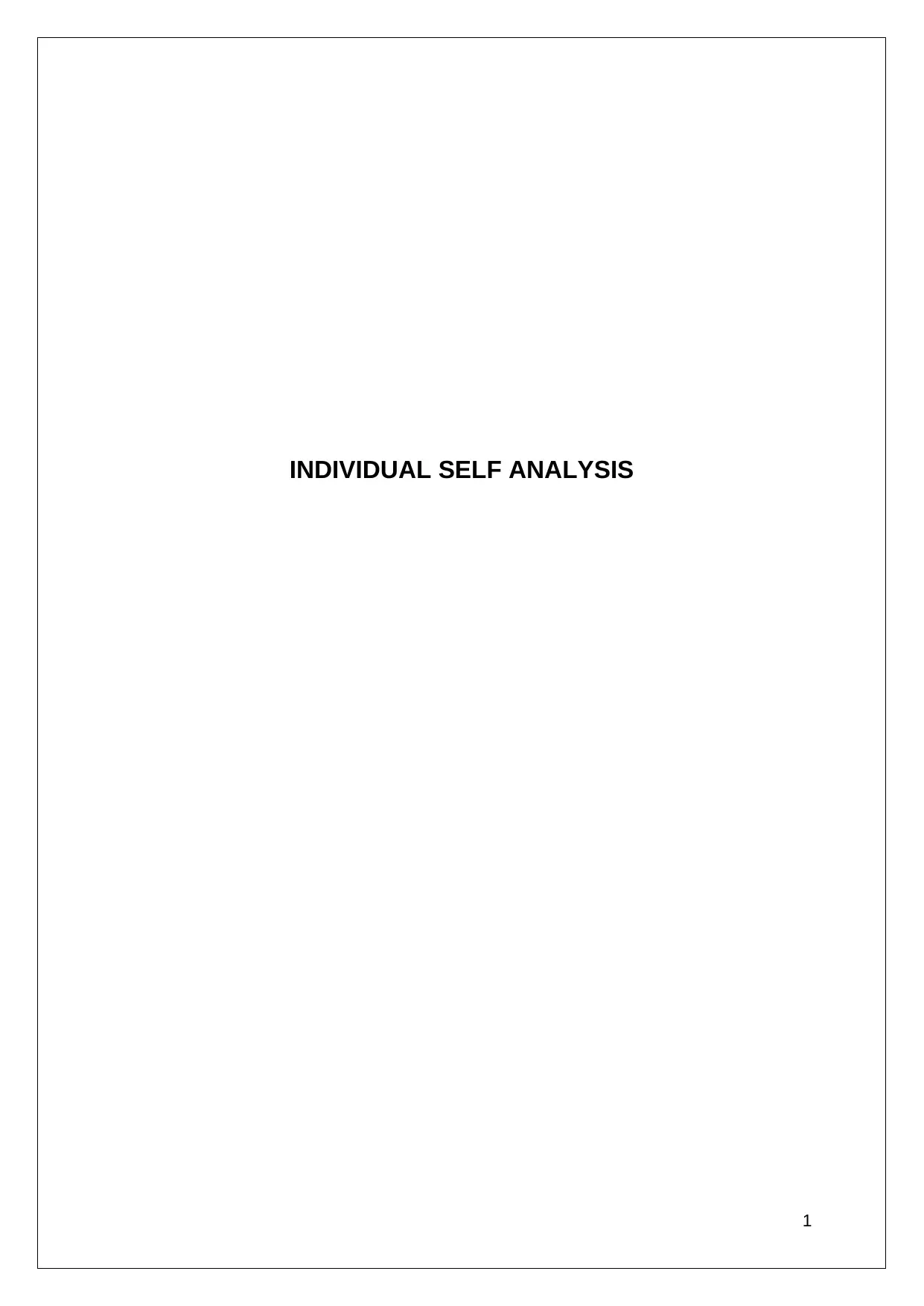
INDIVIDUAL SELF ANALYSIS
1
1
Paraphrase This Document
Need a fresh take? Get an instant paraphrase of this document with our AI Paraphraser
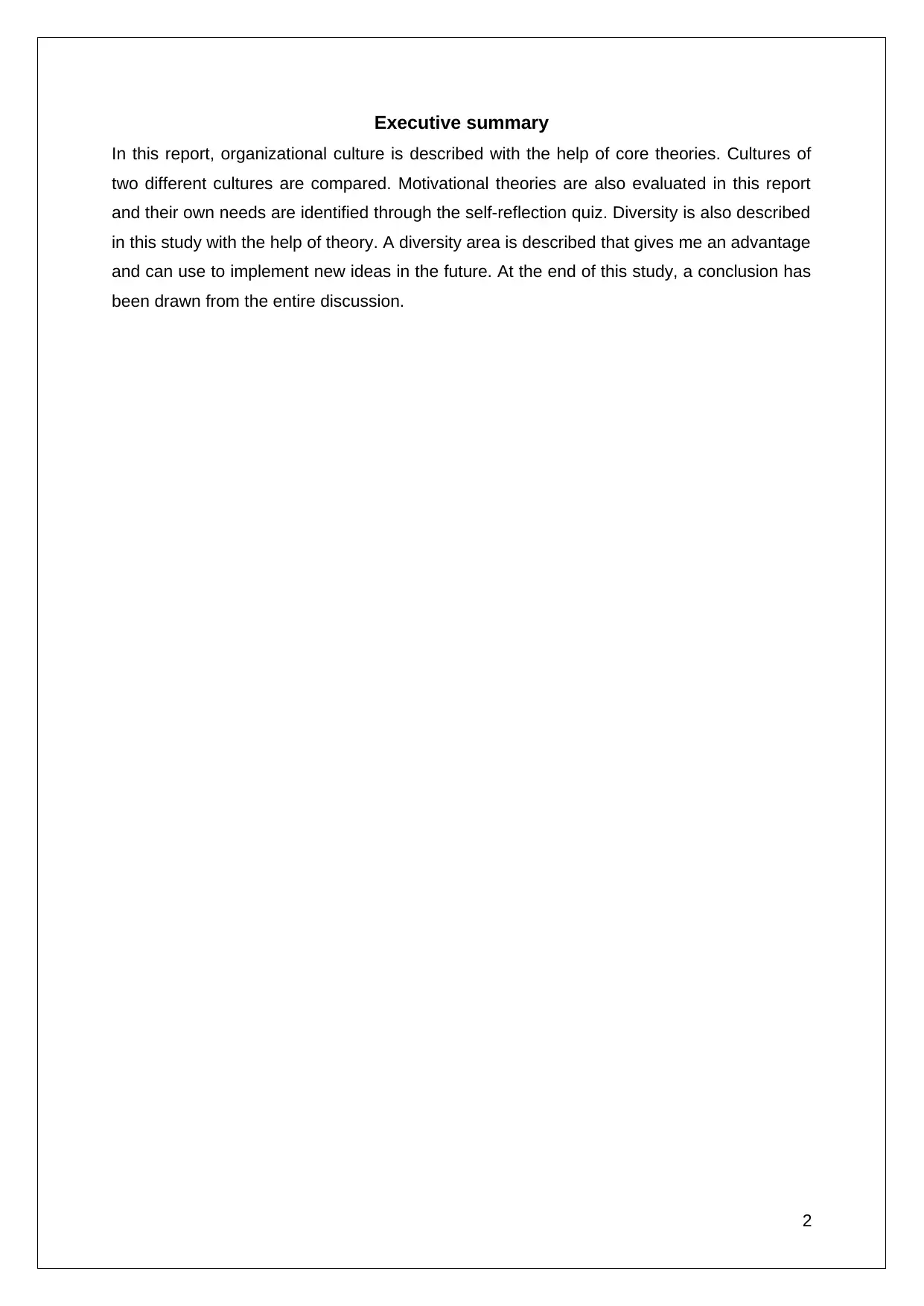
Executive summary
In this report, organizational culture is described with the help of core theories. Cultures of
two different cultures are compared. Motivational theories are also evaluated in this report
and their own needs are identified through the self-reflection quiz. Diversity is also described
in this study with the help of theory. A diversity area is described that gives me an advantage
and can use to implement new ideas in the future. At the end of this study, a conclusion has
been drawn from the entire discussion.
2
In this report, organizational culture is described with the help of core theories. Cultures of
two different cultures are compared. Motivational theories are also evaluated in this report
and their own needs are identified through the self-reflection quiz. Diversity is also described
in this study with the help of theory. A diversity area is described that gives me an advantage
and can use to implement new ideas in the future. At the end of this study, a conclusion has
been drawn from the entire discussion.
2
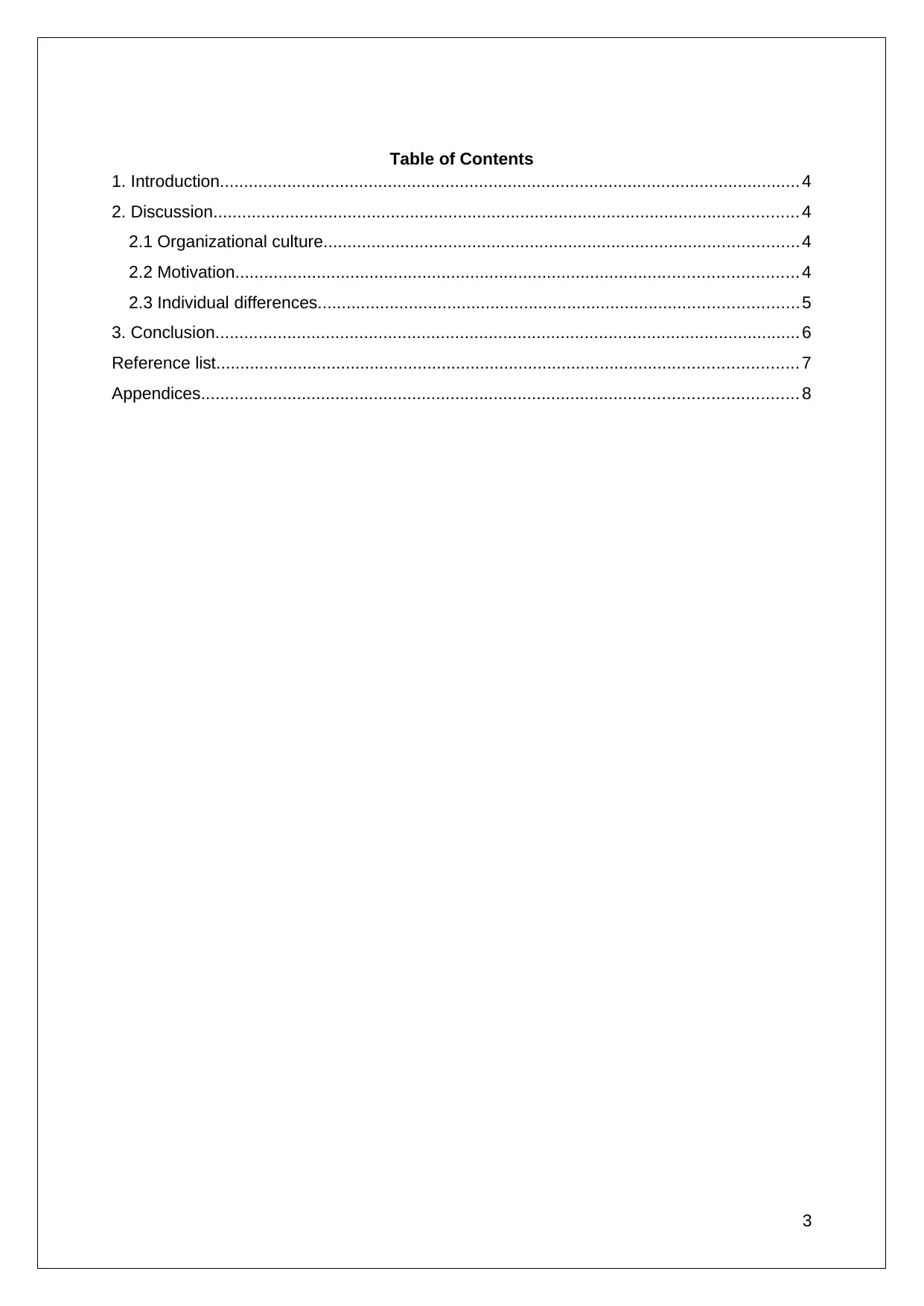
Table of Contents
1. Introduction......................................................................................................................... 4
2. Discussion.......................................................................................................................... 4
2.1 Organizational culture...................................................................................................4
2.2 Motivation..................................................................................................................... 4
2.3 Individual differences....................................................................................................5
3. Conclusion.......................................................................................................................... 6
Reference list......................................................................................................................... 7
Appendices............................................................................................................................ 8
3
1. Introduction......................................................................................................................... 4
2. Discussion.......................................................................................................................... 4
2.1 Organizational culture...................................................................................................4
2.2 Motivation..................................................................................................................... 4
2.3 Individual differences....................................................................................................5
3. Conclusion.......................................................................................................................... 6
Reference list......................................................................................................................... 7
Appendices............................................................................................................................ 8
3
⊘ This is a preview!⊘
Do you want full access?
Subscribe today to unlock all pages.

Trusted by 1+ million students worldwide
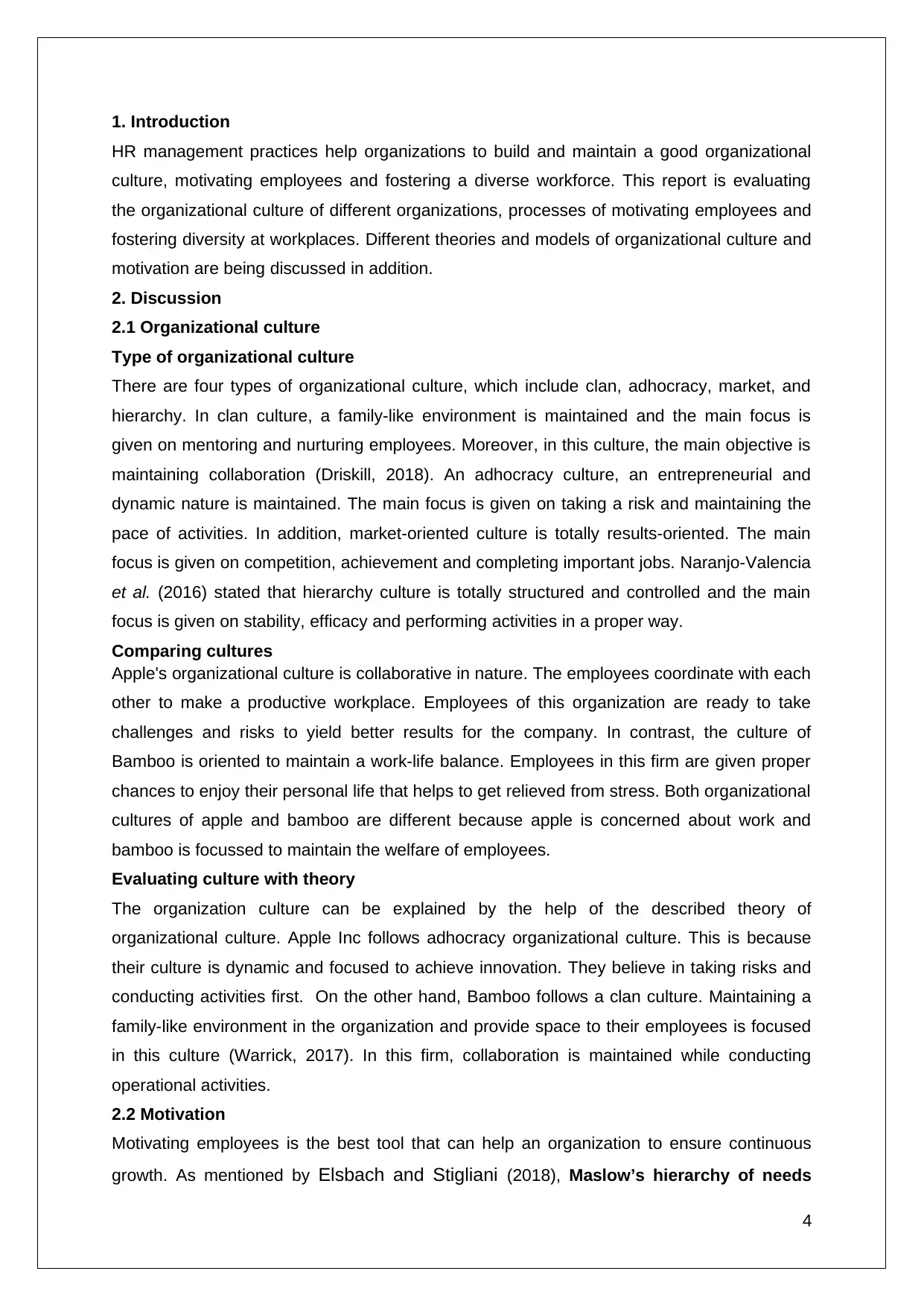
1. Introduction
HR management practices help organizations to build and maintain a good organizational
culture, motivating employees and fostering a diverse workforce. This report is evaluating
the organizational culture of different organizations, processes of motivating employees and
fostering diversity at workplaces. Different theories and models of organizational culture and
motivation are being discussed in addition.
2. Discussion
2.1 Organizational culture
Type of organizational culture
There are four types of organizational culture, which include clan, adhocracy, market, and
hierarchy. In clan culture, a family-like environment is maintained and the main focus is
given on mentoring and nurturing employees. Moreover, in this culture, the main objective is
maintaining collaboration (Driskill, 2018). An adhocracy culture, an entrepreneurial and
dynamic nature is maintained. The main focus is given on taking a risk and maintaining the
pace of activities. In addition, market-oriented culture is totally results-oriented. The main
focus is given on competition, achievement and completing important jobs. Naranjo-Valencia
et al. (2016) stated that hierarchy culture is totally structured and controlled and the main
focus is given on stability, efficacy and performing activities in a proper way.
Comparing cultures
Apple's organizational culture is collaborative in nature. The employees coordinate with each
other to make a productive workplace. Employees of this organization are ready to take
challenges and risks to yield better results for the company. In contrast, the culture of
Bamboo is oriented to maintain a work-life balance. Employees in this firm are given proper
chances to enjoy their personal life that helps to get relieved from stress. Both organizational
cultures of apple and bamboo are different because apple is concerned about work and
bamboo is focussed to maintain the welfare of employees.
Evaluating culture with theory
The organization culture can be explained by the help of the described theory of
organizational culture. Apple Inc follows adhocracy organizational culture. This is because
their culture is dynamic and focused to achieve innovation. They believe in taking risks and
conducting activities first. On the other hand, Bamboo follows a clan culture. Maintaining a
family-like environment in the organization and provide space to their employees is focused
in this culture (Warrick, 2017). In this firm, collaboration is maintained while conducting
operational activities.
2.2 Motivation
Motivating employees is the best tool that can help an organization to ensure continuous
growth. As mentioned by Elsbach and Stigliani (2018), Maslow’s hierarchy of needs
4
HR management practices help organizations to build and maintain a good organizational
culture, motivating employees and fostering a diverse workforce. This report is evaluating
the organizational culture of different organizations, processes of motivating employees and
fostering diversity at workplaces. Different theories and models of organizational culture and
motivation are being discussed in addition.
2. Discussion
2.1 Organizational culture
Type of organizational culture
There are four types of organizational culture, which include clan, adhocracy, market, and
hierarchy. In clan culture, a family-like environment is maintained and the main focus is
given on mentoring and nurturing employees. Moreover, in this culture, the main objective is
maintaining collaboration (Driskill, 2018). An adhocracy culture, an entrepreneurial and
dynamic nature is maintained. The main focus is given on taking a risk and maintaining the
pace of activities. In addition, market-oriented culture is totally results-oriented. The main
focus is given on competition, achievement and completing important jobs. Naranjo-Valencia
et al. (2016) stated that hierarchy culture is totally structured and controlled and the main
focus is given on stability, efficacy and performing activities in a proper way.
Comparing cultures
Apple's organizational culture is collaborative in nature. The employees coordinate with each
other to make a productive workplace. Employees of this organization are ready to take
challenges and risks to yield better results for the company. In contrast, the culture of
Bamboo is oriented to maintain a work-life balance. Employees in this firm are given proper
chances to enjoy their personal life that helps to get relieved from stress. Both organizational
cultures of apple and bamboo are different because apple is concerned about work and
bamboo is focussed to maintain the welfare of employees.
Evaluating culture with theory
The organization culture can be explained by the help of the described theory of
organizational culture. Apple Inc follows adhocracy organizational culture. This is because
their culture is dynamic and focused to achieve innovation. They believe in taking risks and
conducting activities first. On the other hand, Bamboo follows a clan culture. Maintaining a
family-like environment in the organization and provide space to their employees is focused
in this culture (Warrick, 2017). In this firm, collaboration is maintained while conducting
operational activities.
2.2 Motivation
Motivating employees is the best tool that can help an organization to ensure continuous
growth. As mentioned by Elsbach and Stigliani (2018), Maslow’s hierarchy of needs
4
Paraphrase This Document
Need a fresh take? Get an instant paraphrase of this document with our AI Paraphraser
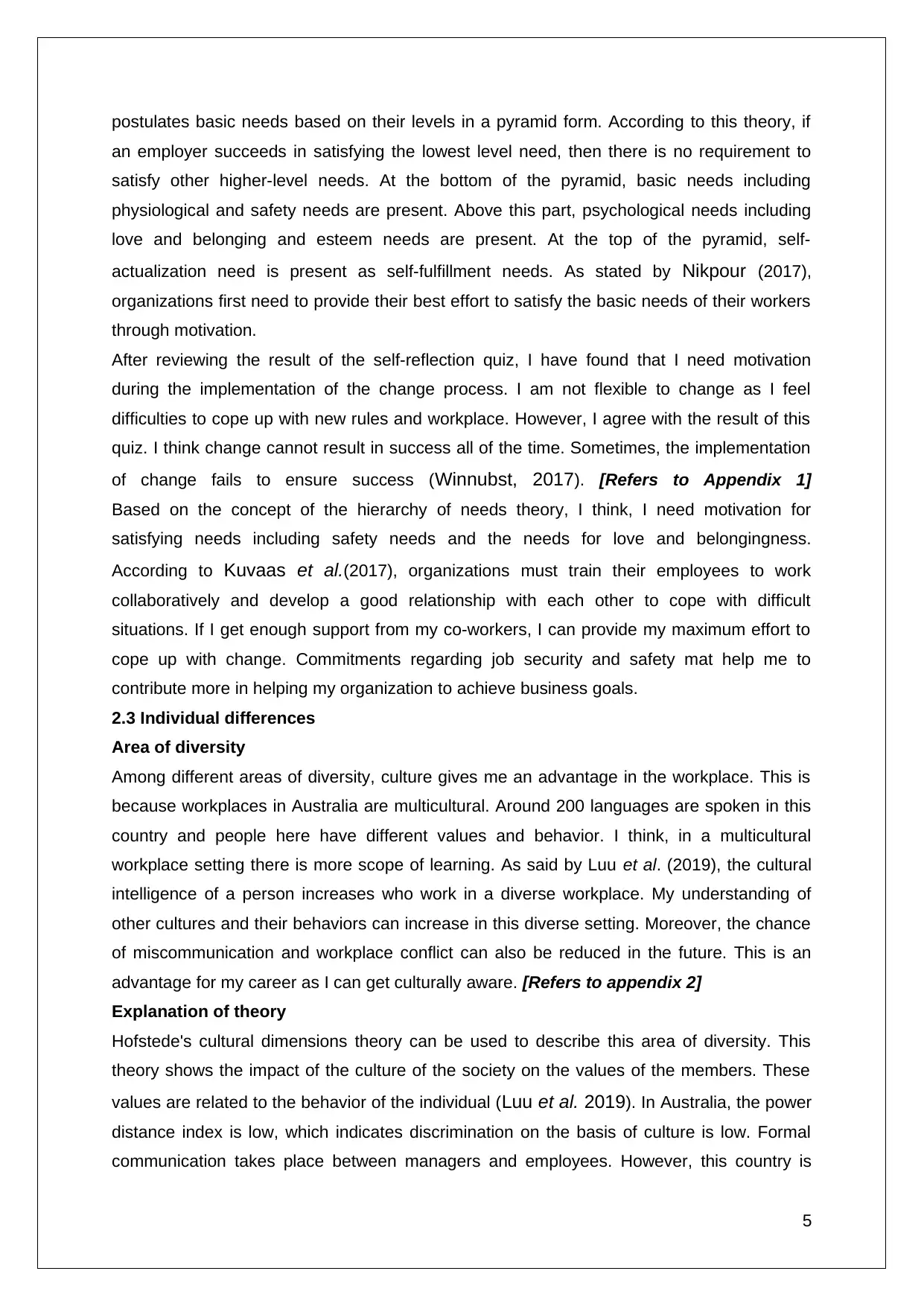
postulates basic needs based on their levels in a pyramid form. According to this theory, if
an employer succeeds in satisfying the lowest level need, then there is no requirement to
satisfy other higher-level needs. At the bottom of the pyramid, basic needs including
physiological and safety needs are present. Above this part, psychological needs including
love and belonging and esteem needs are present. At the top of the pyramid, self-
actualization need is present as self-fulfillment needs. As stated by Nikpour (2017),
organizations first need to provide their best effort to satisfy the basic needs of their workers
through motivation.
After reviewing the result of the self-reflection quiz, I have found that I need motivation
during the implementation of the change process. I am not flexible to change as I feel
difficulties to cope up with new rules and workplace. However, I agree with the result of this
quiz. I think change cannot result in success all of the time. Sometimes, the implementation
of change fails to ensure success (Winnubst, 2017). [Refers to Appendix 1]
Based on the concept of the hierarchy of needs theory, I think, I need motivation for
satisfying needs including safety needs and the needs for love and belongingness.
According to Kuvaas et al.(2017), organizations must train their employees to work
collaboratively and develop a good relationship with each other to cope with difficult
situations. If I get enough support from my co-workers, I can provide my maximum effort to
cope up with change. Commitments regarding job security and safety mat help me to
contribute more in helping my organization to achieve business goals.
2.3 Individual differences
Area of diversity
Among different areas of diversity, culture gives me an advantage in the workplace. This is
because workplaces in Australia are multicultural. Around 200 languages are spoken in this
country and people here have different values and behavior. I think, in a multicultural
workplace setting there is more scope of learning. As said by Luu et al. (2019), the cultural
intelligence of a person increases who work in a diverse workplace. My understanding of
other cultures and their behaviors can increase in this diverse setting. Moreover, the chance
of miscommunication and workplace conflict can also be reduced in the future. This is an
advantage for my career as I can get culturally aware. [Refers to appendix 2]
Explanation of theory
Hofstede's cultural dimensions theory can be used to describe this area of diversity. This
theory shows the impact of the culture of the society on the values of the members. These
values are related to the behavior of the individual (Luu et al. 2019). In Australia, the power
distance index is low, which indicates discrimination on the basis of culture is low. Formal
communication takes place between managers and employees. However, this country is
5
an employer succeeds in satisfying the lowest level need, then there is no requirement to
satisfy other higher-level needs. At the bottom of the pyramid, basic needs including
physiological and safety needs are present. Above this part, psychological needs including
love and belonging and esteem needs are present. At the top of the pyramid, self-
actualization need is present as self-fulfillment needs. As stated by Nikpour (2017),
organizations first need to provide their best effort to satisfy the basic needs of their workers
through motivation.
After reviewing the result of the self-reflection quiz, I have found that I need motivation
during the implementation of the change process. I am not flexible to change as I feel
difficulties to cope up with new rules and workplace. However, I agree with the result of this
quiz. I think change cannot result in success all of the time. Sometimes, the implementation
of change fails to ensure success (Winnubst, 2017). [Refers to Appendix 1]
Based on the concept of the hierarchy of needs theory, I think, I need motivation for
satisfying needs including safety needs and the needs for love and belongingness.
According to Kuvaas et al.(2017), organizations must train their employees to work
collaboratively and develop a good relationship with each other to cope with difficult
situations. If I get enough support from my co-workers, I can provide my maximum effort to
cope up with change. Commitments regarding job security and safety mat help me to
contribute more in helping my organization to achieve business goals.
2.3 Individual differences
Area of diversity
Among different areas of diversity, culture gives me an advantage in the workplace. This is
because workplaces in Australia are multicultural. Around 200 languages are spoken in this
country and people here have different values and behavior. I think, in a multicultural
workplace setting there is more scope of learning. As said by Luu et al. (2019), the cultural
intelligence of a person increases who work in a diverse workplace. My understanding of
other cultures and their behaviors can increase in this diverse setting. Moreover, the chance
of miscommunication and workplace conflict can also be reduced in the future. This is an
advantage for my career as I can get culturally aware. [Refers to appendix 2]
Explanation of theory
Hofstede's cultural dimensions theory can be used to describe this area of diversity. This
theory shows the impact of the culture of the society on the values of the members. These
values are related to the behavior of the individual (Luu et al. 2019). In Australia, the power
distance index is low, which indicates discrimination on the basis of culture is low. Formal
communication takes place between managers and employees. However, this country is
5
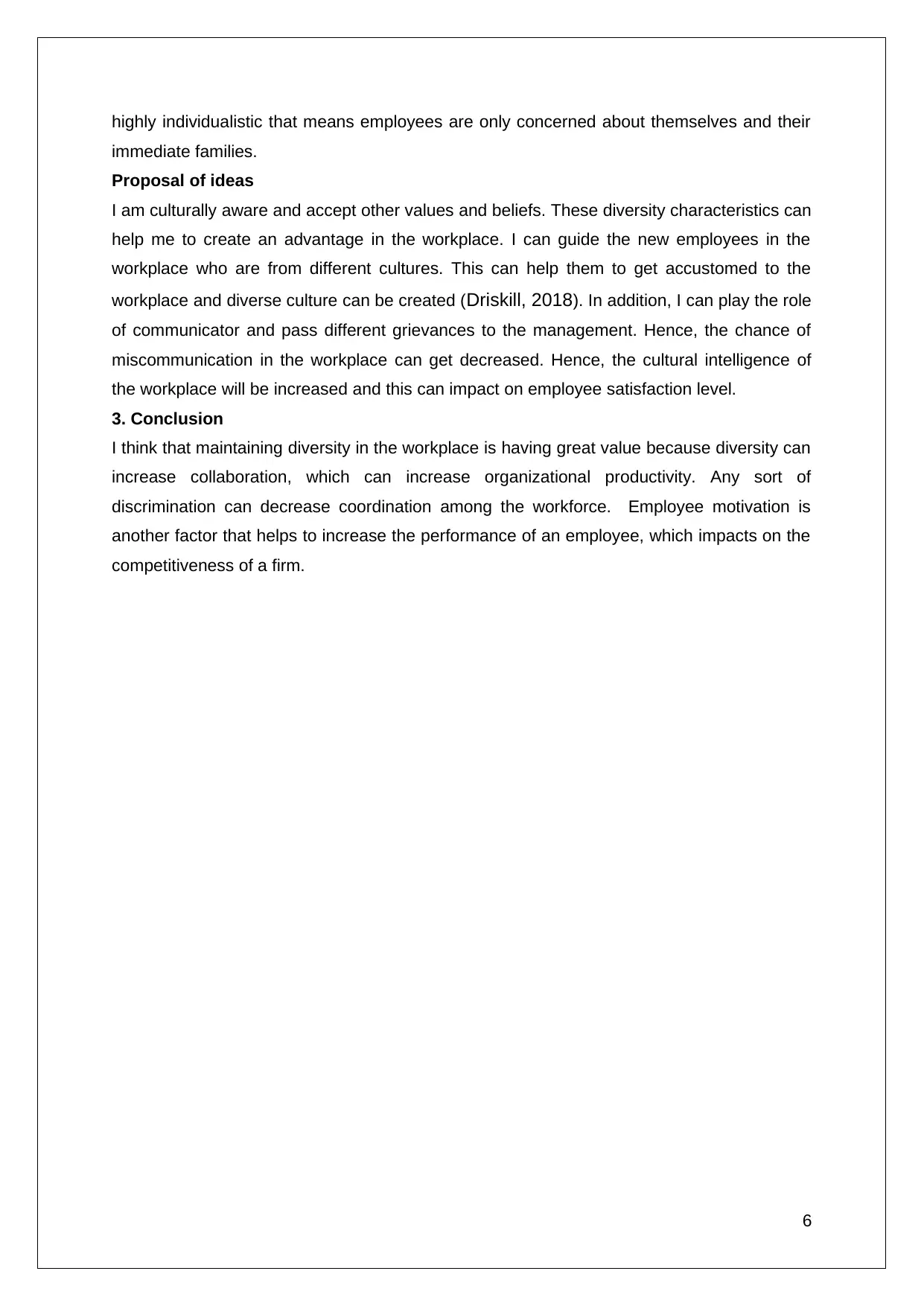
highly individualistic that means employees are only concerned about themselves and their
immediate families.
Proposal of ideas
I am culturally aware and accept other values and beliefs. These diversity characteristics can
help me to create an advantage in the workplace. I can guide the new employees in the
workplace who are from different cultures. This can help them to get accustomed to the
workplace and diverse culture can be created (Driskill, 2018). In addition, I can play the role
of communicator and pass different grievances to the management. Hence, the chance of
miscommunication in the workplace can get decreased. Hence, the cultural intelligence of
the workplace will be increased and this can impact on employee satisfaction level.
3. Conclusion
I think that maintaining diversity in the workplace is having great value because diversity can
increase collaboration, which can increase organizational productivity. Any sort of
discrimination can decrease coordination among the workforce. Employee motivation is
another factor that helps to increase the performance of an employee, which impacts on the
competitiveness of a firm.
6
immediate families.
Proposal of ideas
I am culturally aware and accept other values and beliefs. These diversity characteristics can
help me to create an advantage in the workplace. I can guide the new employees in the
workplace who are from different cultures. This can help them to get accustomed to the
workplace and diverse culture can be created (Driskill, 2018). In addition, I can play the role
of communicator and pass different grievances to the management. Hence, the chance of
miscommunication in the workplace can get decreased. Hence, the cultural intelligence of
the workplace will be increased and this can impact on employee satisfaction level.
3. Conclusion
I think that maintaining diversity in the workplace is having great value because diversity can
increase collaboration, which can increase organizational productivity. Any sort of
discrimination can decrease coordination among the workforce. Employee motivation is
another factor that helps to increase the performance of an employee, which impacts on the
competitiveness of a firm.
6
⊘ This is a preview!⊘
Do you want full access?
Subscribe today to unlock all pages.

Trusted by 1+ million students worldwide
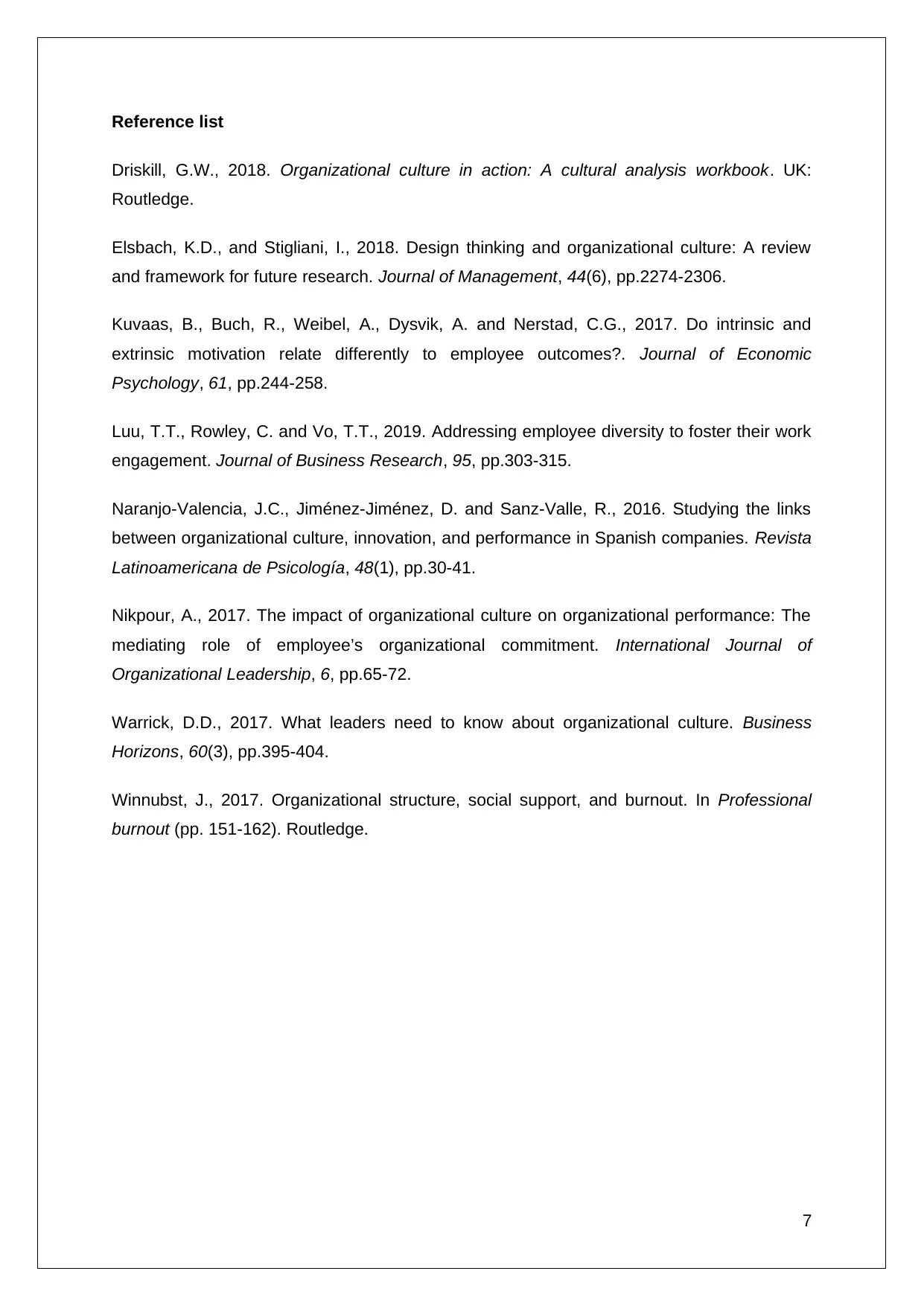
Reference list
Driskill, G.W., 2018. Organizational culture in action: A cultural analysis workbook. UK:
Routledge.
Elsbach, K.D., and Stigliani, I., 2018. Design thinking and organizational culture: A review
and framework for future research. Journal of Management, 44(6), pp.2274-2306.
Kuvaas, B., Buch, R., Weibel, A., Dysvik, A. and Nerstad, C.G., 2017. Do intrinsic and
extrinsic motivation relate differently to employee outcomes?. Journal of Economic
Psychology, 61, pp.244-258.
Luu, T.T., Rowley, C. and Vo, T.T., 2019. Addressing employee diversity to foster their work
engagement. Journal of Business Research, 95, pp.303-315.
Naranjo-Valencia, J.C., Jiménez-Jiménez, D. and Sanz-Valle, R., 2016. Studying the links
between organizational culture, innovation, and performance in Spanish companies. Revista
Latinoamericana de Psicología, 48(1), pp.30-41.
Nikpour, A., 2017. The impact of organizational culture on organizational performance: The
mediating role of employee’s organizational commitment. International Journal of
Organizational Leadership, 6, pp.65-72.
Warrick, D.D., 2017. What leaders need to know about organizational culture. Business
Horizons, 60(3), pp.395-404.
Winnubst, J., 2017. Organizational structure, social support, and burnout. In Professional
burnout (pp. 151-162). Routledge.
7
Driskill, G.W., 2018. Organizational culture in action: A cultural analysis workbook. UK:
Routledge.
Elsbach, K.D., and Stigliani, I., 2018. Design thinking and organizational culture: A review
and framework for future research. Journal of Management, 44(6), pp.2274-2306.
Kuvaas, B., Buch, R., Weibel, A., Dysvik, A. and Nerstad, C.G., 2017. Do intrinsic and
extrinsic motivation relate differently to employee outcomes?. Journal of Economic
Psychology, 61, pp.244-258.
Luu, T.T., Rowley, C. and Vo, T.T., 2019. Addressing employee diversity to foster their work
engagement. Journal of Business Research, 95, pp.303-315.
Naranjo-Valencia, J.C., Jiménez-Jiménez, D. and Sanz-Valle, R., 2016. Studying the links
between organizational culture, innovation, and performance in Spanish companies. Revista
Latinoamericana de Psicología, 48(1), pp.30-41.
Nikpour, A., 2017. The impact of organizational culture on organizational performance: The
mediating role of employee’s organizational commitment. International Journal of
Organizational Leadership, 6, pp.65-72.
Warrick, D.D., 2017. What leaders need to know about organizational culture. Business
Horizons, 60(3), pp.395-404.
Winnubst, J., 2017. Organizational structure, social support, and burnout. In Professional
burnout (pp. 151-162). Routledge.
7
Paraphrase This Document
Need a fresh take? Get an instant paraphrase of this document with our AI Paraphraser
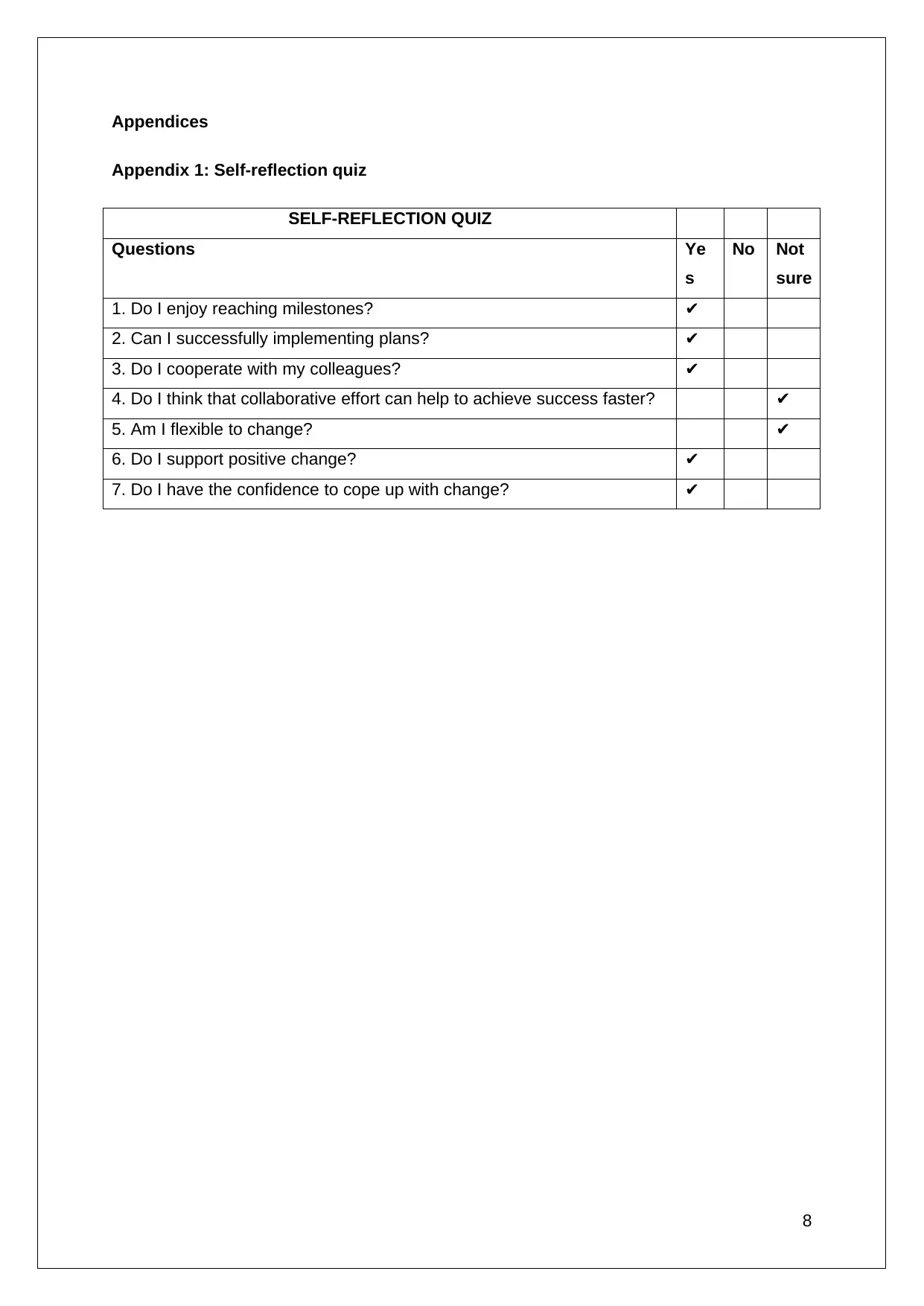
Appendices
Appendix 1: Self-reflection quiz
SELF-REFLECTION QUIZ
Questions Ye
s
No Not
sure
1. Do I enjoy reaching milestones? ✔
2. Can I successfully implementing plans? ✔
3. Do I cooperate with my colleagues? ✔
4. Do I think that collaborative effort can help to achieve success faster? ✔
5. Am I flexible to change? ✔
6. Do I support positive change? ✔
7. Do I have the confidence to cope up with change? ✔
8
Appendix 1: Self-reflection quiz
SELF-REFLECTION QUIZ
Questions Ye
s
No Not
sure
1. Do I enjoy reaching milestones? ✔
2. Can I successfully implementing plans? ✔
3. Do I cooperate with my colleagues? ✔
4. Do I think that collaborative effort can help to achieve success faster? ✔
5. Am I flexible to change? ✔
6. Do I support positive change? ✔
7. Do I have the confidence to cope up with change? ✔
8
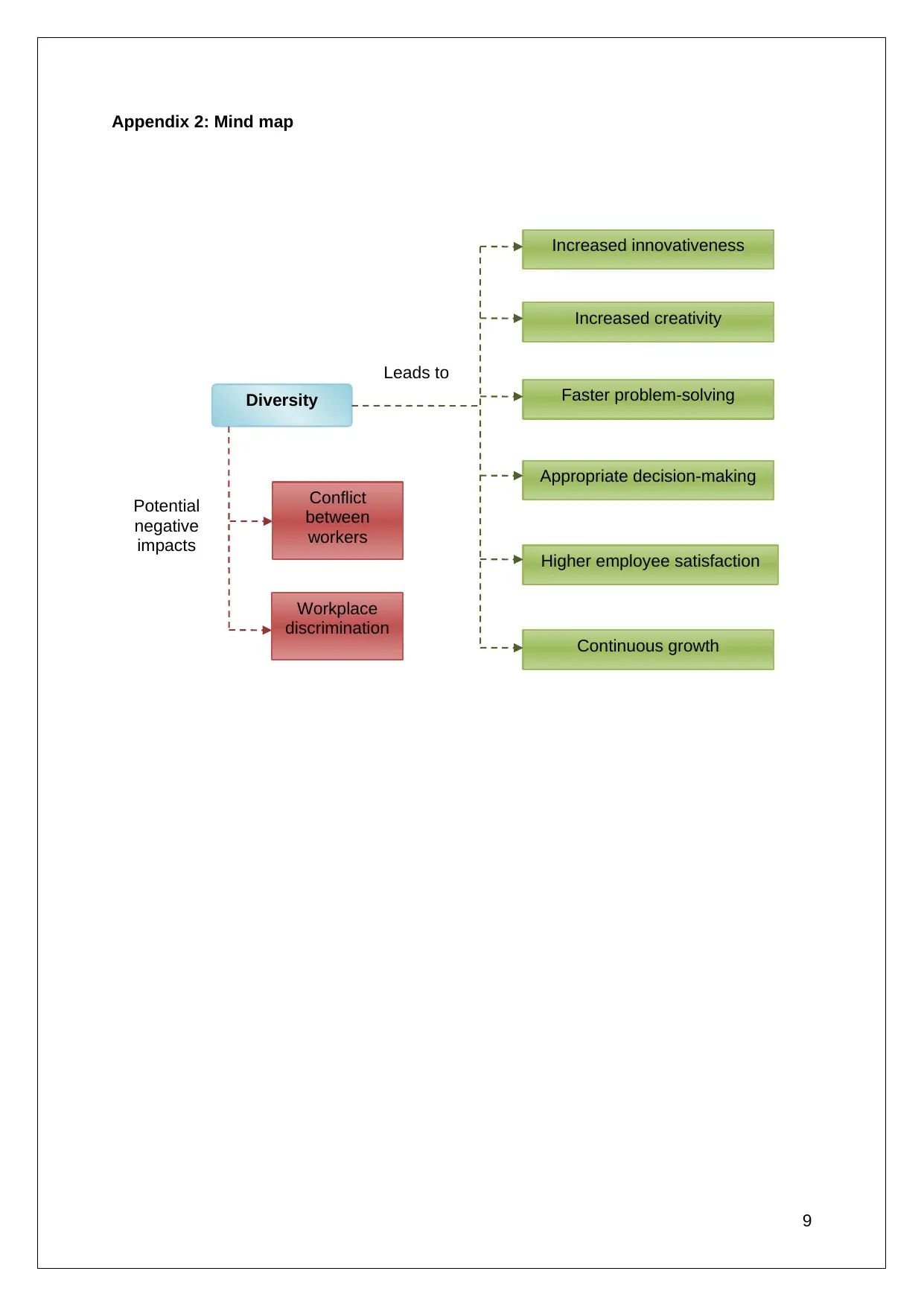
Diversity
Increased creativity
Leads to
Workplace
discrimination
Increased innovativeness
Faster problem-solving
Appropriate decision-making
Higher employee satisfaction
Continuous growth
Conflict
between
workers
Potential
negative
impacts
Appendix 2: Mind map
9
Increased creativity
Leads to
Workplace
discrimination
Increased innovativeness
Faster problem-solving
Appropriate decision-making
Higher employee satisfaction
Continuous growth
Conflict
between
workers
Potential
negative
impacts
Appendix 2: Mind map
9
⊘ This is a preview!⊘
Do you want full access?
Subscribe today to unlock all pages.

Trusted by 1+ million students worldwide
1 out of 9
Related Documents
Your All-in-One AI-Powered Toolkit for Academic Success.
+13062052269
info@desklib.com
Available 24*7 on WhatsApp / Email
![[object Object]](/_next/static/media/star-bottom.7253800d.svg)
Unlock your academic potential
Copyright © 2020–2025 A2Z Services. All Rights Reserved. Developed and managed by ZUCOL.




